

The revitalised MG Rover Group has done a good job. Only a few years after BMW left the company for dead we are witnessing a brave British company taking the fight to most of the big hitters in the industry. Instrumental in Rover's survival is the Rover 75. The Car Enthusiast have already driven a Rover 75 estate and the fabulous 75-based MG ZT 190 so we are familiar with the saloon's architecture. All the better to review the latest offering - a 1.8-litre turbocharged 75 simply titled the 75 1.8T.
Not many people would associate turbocharging with luxury saloon car driving. Rover have managed to combine both, and to be honest, if you didn't know it had a turbo, and it didn't say "T" on the boot then you would possibly not guess. There is no discernible turbo whistle, which is not too surprising as the Rover installation is not particularly high-boost. Unfortunately, the base 1.8-litre engine is not the most refined, though it is only really noticeable when pushing the revs a little while overtaking. It is at such times that you will appreciate the extra torque released from the engine. In truth it feels like a larger capacity engine. The thrust may not shove you back in the seat, but it will move you past slow traffic safely and efficiently.
Efficiency is one of the main reasons this car exists. Today's company car driver watches CO2 figures when choosing what to drive. This is directly linked to fuel usage. Now, when you think of turbocharging in the way the Evo VII and its ilk are done fuel economy is not foremost in your thoughts. However, turbocharging allows for downsizing. If you have not yet heard this term, you soon will. Many manufacturers have already begun the process. For instance, Mercedes offer several versions of the C-class saloon such as the C180, C200, C220. No longer do the numbers relate to the engine's capacity. They share the same engine, but with different electronics releasing the correct power for the price. So long as it delivers the customer's requirements then everyone wins right?
As a fellow car enthusiast you may not like the sound of this concept at all. However, it makes sense. Take the Rover. It ambles along the motorway at 70mph with the engine barely at 3000rpm. At this point, the turbo is not doing much, and the engine is pretty efficient, with a swept volume of only 1.8 litres. Put your foot down at this stage in a regular 1.8-litre and not very much will happen. Do it in the Rover and you will be pleasantly surprised by the forward thrust. That'll be the turbo. So, along with acceptable fuel consumption you have access to performance only when you actually need it. Downsizing makes sense then as an idea. Does it work in the Rover?
The figures tell some of the story. 0-60mph takes only 9.1 seconds and the top speed of 130mph would not be sniffed at on the German autobahns. At the same time, the combined fuel economy figure is a respectable 35.3mpg and the CO2 emissions are 193 g/km. That's not bad going for a car of the Rover's size. It will, after all, easily swallow five passengers and a lot of their weekend luggage.
Your passengers will be comfortable too. The interior is a nice place to be. The leather seats and climate control cosset. The driver does not get a raw deal either. Not only does he/she get all the creature comforts including heated seats, but the controls are all well weighted and a joy to use. The gearlever appears to be too big (I don't like the wood trim in general) but it falls to hand easily and happens to be linked to a fine five-speed manual transmission. The steering wheel is a bit of a let down - I would prefer softer leather. Unfortunately the steering can be a little vague on the motorway too, though the car itself handles very well. The pedals are well spaced and the brakes in particular inspire confidence.
You may have noticed that the Rover 75 silhouette has not been changed since it was released. I for one am quite happy about that. It is a pleasant and distinctive shape. It really does stand out from the horde of Mondeos and Vectras on the inside and out. This alone should be reason for it to succeed, and MG Rover with it.
Rivals
The Rover 75 1.8T is £22,120. This puts it into BMW 3-series and even Jaguar X-type territory. For the same money you can of course choose a Ford Mondeo, Peugeot 406, Citroen C5 and Honda Accord. The list goes on. Our choice would be the Alfa Romeo 156 2.5 V6 Lusso which comes in at £20,750. However, the Rover is substantially larger. The Citroen C5 3.0i V6 Exclusive is a fraction more expensive, just as big and well equipped. However, as nice as a V6 engine is, its CO2 figure is a whopping 241 g/km, which would be a large disadvantage for the business buyer. At the end of the day, it depends on your needs. The Rover is comfortable, adequately quick, well equipped and spacious. It also manages to be frugal and panders to company drivers on a budget.
Links
www.mg-rover.com
SUMMARY
Performance:     
The turbocharger imbues this large saloon with adequate pace, but it could be described as sparkling rather than causing sparks.
Engine:     
Unfortunately, this engine does not suit the character of the car. It would be better suited to a hot hatch. The rating is more of the engine in this application.
Handling:     
The Rover 75 and MG ZT brothers share a solid, communicative chassis. This version of the 75 though is let down by slightly dull steering.
Economy:     
The economy figures will not win awards, but the downsizing philosophy works in favour of economy and emissions so we have awarded a healthy four stars to the 1.8T. Only true fuel misers will be awarded the full five stars.
Tactility:     
The steering is the main reason for loss of stars. Also, it is too easy to lose grip while exiting a junction. At the same time we found the car easy to stall and difficult to drive smoothly in town. These niggles reduce the rating a little unfortunately.
Appearance:     
I would not feel right awarding a saloon like this five stars! It is a good looking car, especially in the test car's "Monogram Bacchus Supertallic" paintwork. It perhaps conveys a more sophisticated and mature image than I would personally want to convey...
Interior:     
Though the interior is not perfect, it has some lovely distinctive features - the ovular instruments for instance. The seats and space are good too, and it well equipped, light and airy. It is hard to fault.
Safety:     
There is an array of airbags for the driver and passenger, and the obligatory ABS, etc. It does not move the game on though with stability control etc.
Equipment:     
The 1.8T comes with electric, heated front seats, leather upholstery, climate control, airbags, a decent stereo, parking aids and an alarm and immobiliser. The only thing on the extras list we would also want as standard are the excellent projector headlamps (£200). The test car was also fitted with satellite navigation, but the £2,325 price is a bit steep.
Road test / new car review: 2002 Rover 75 1.8T Connoisseur SE
Story by Shane O' Donoghue and images by Mark Sims
|

|
|
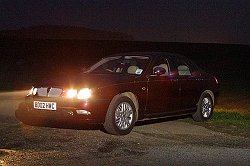
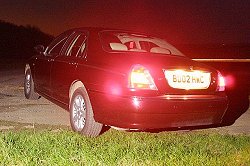
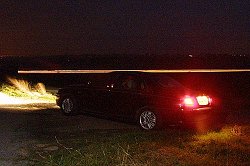
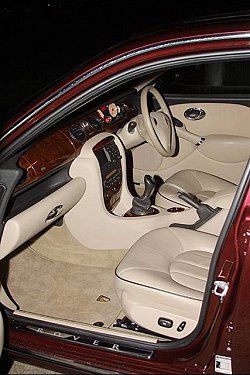
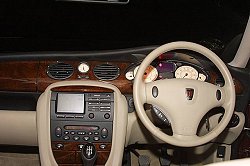
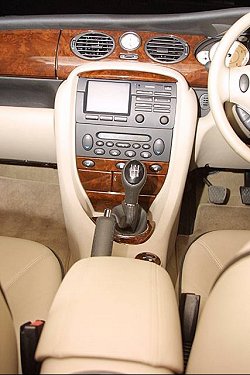
|





